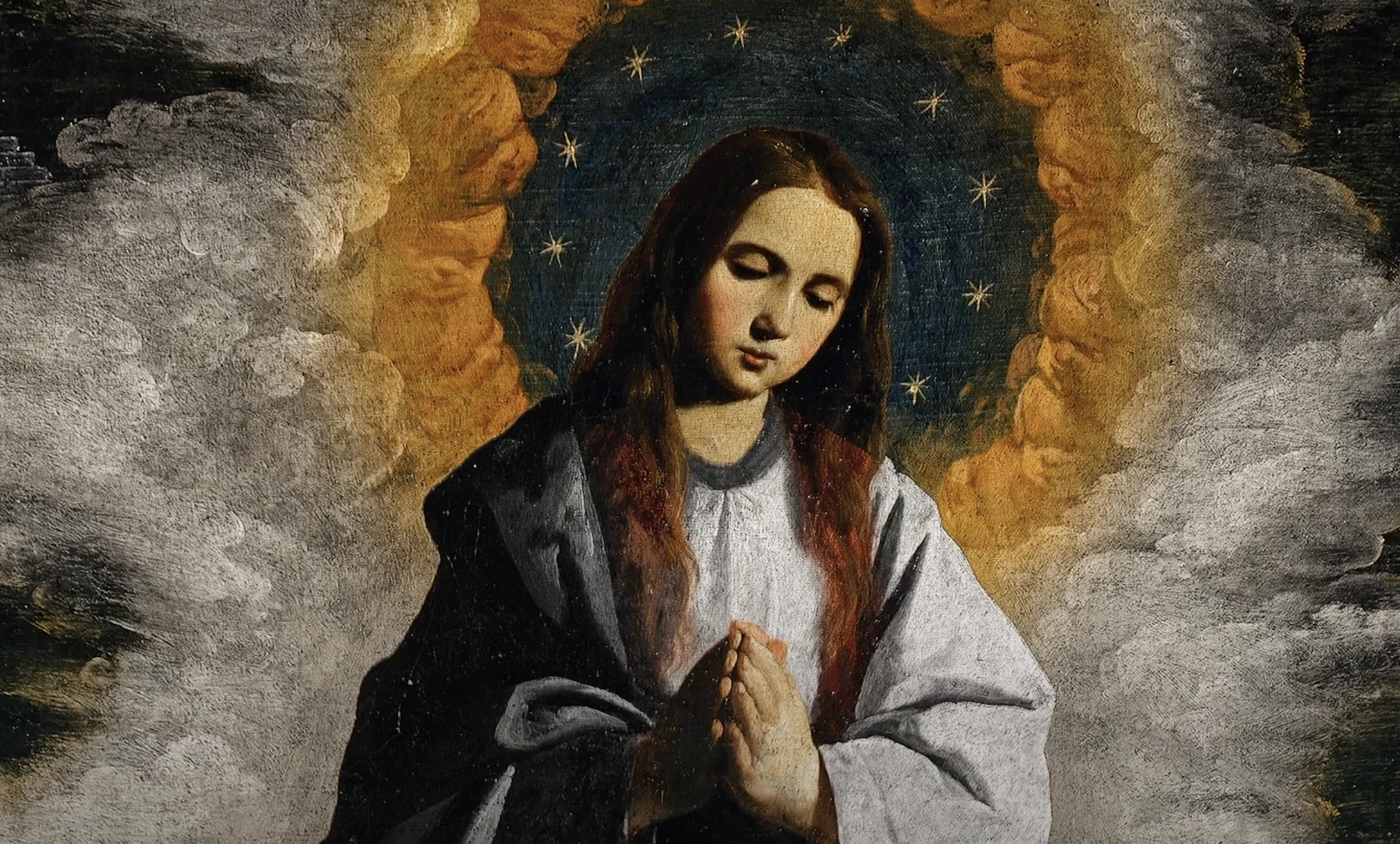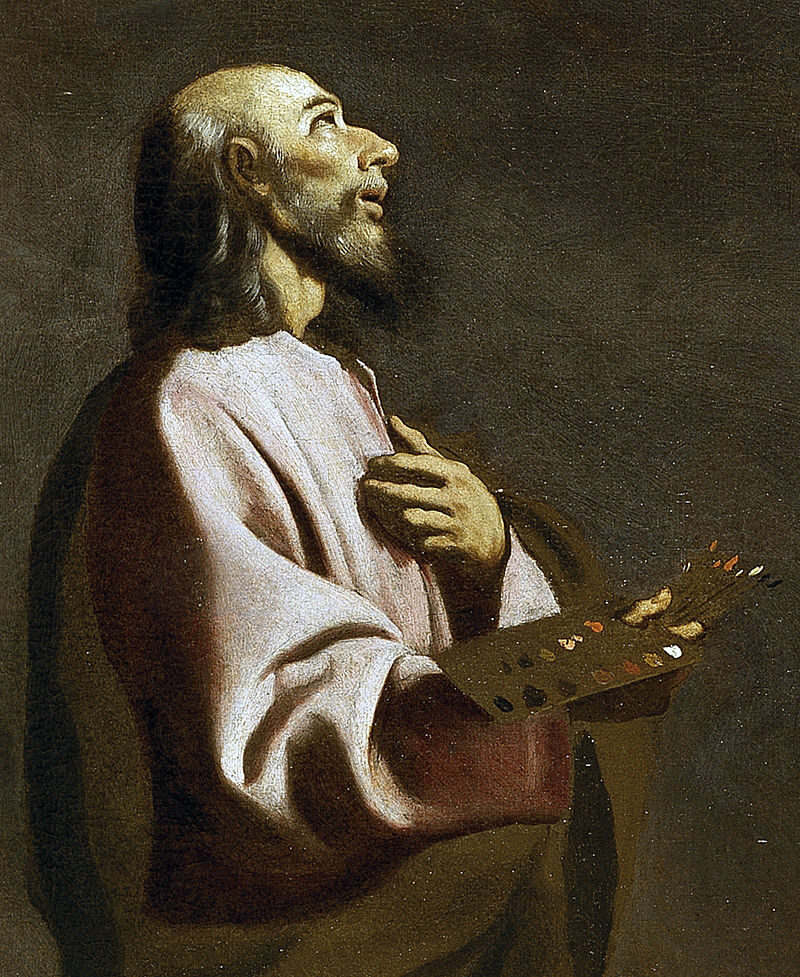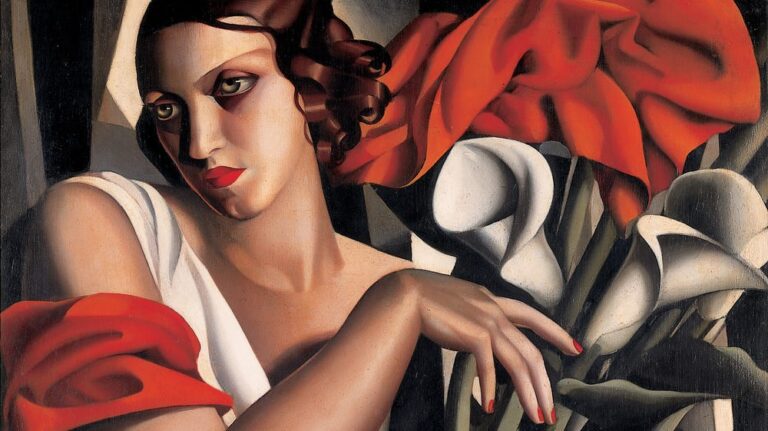Francisco de Zurbarán Painter: The Masterful Spanish Baroque Artist
Born: Baptized 7 November 1598, Badajoz, Extremadura, Spain
Death: 27 August 1664, Madrid, Spain
Art Movement: Baroque, Caravaggisti
Nationality: Spanish
Teacher: Pedro Díaz de Villanueva
Francisco de Zurbarán Painter: The Masterful Spanish Baroque Artist
Early Life and Formation
Francisco de Zurbarán’s journey to becoming one of Spain’s most influential Baroque painters began in a small town and developed through formal training and strategic relocations.
His natural talent and religious sensibility shaped his distinctive artistic style from an early age.
Birthplace and formative years in Fuente de Cantos
Francisco de Zurbarán was baptized on November 7, 1598, in Fuente de Cantos, a small town in the Extremadura region of Spain. Born to humble parents, he showed remarkable artistic talent during his childhood years.

St. Bartholomew Almost in Agony (1626–1632)
Even as a young boy, Zurbarán demonstrated his natural abilities by sketching objects using charcoal.
His family recognized his artistic inclinations early on. This early period in Fuente de Cantos laid the foundation for what would become an illustrious career in Spanish religious art.
Though information about his earliest education remains limited, these formative years clearly nurtured the observational skills that would later distinguish his work.
Apprenticeship and move to Llerena
In 1614, at approximately age 16, Zurbarán’s father sent him to Seville to begin formal artistic training. There, he apprenticed with Pedro Díaz de Villanueva for three years, learning the technical foundations of painting.
This apprenticeship provided him with the necessary skills in composition, color theory, and painting techniques essential for his future works.
After completing his training in 1617, Zurbarán returned to the province of his birth, settling in the nearby town of Llerena. This move marked his first professional establishment as an independent artist.
In Llerena, he began accepting commissions and developing his distinctive style.
This period served as a transitional phase where Zurbarán refined his approach to realistic depiction and dramatic lighting that would later become his hallmark.
Establishment in Seville
By 1629, Zurbarán had returned to Seville, Spain’s artistic center during the Golden Age. This strategic move positioned him in the heart of Spain’s artistic community where patronage and opportunities were abundant.
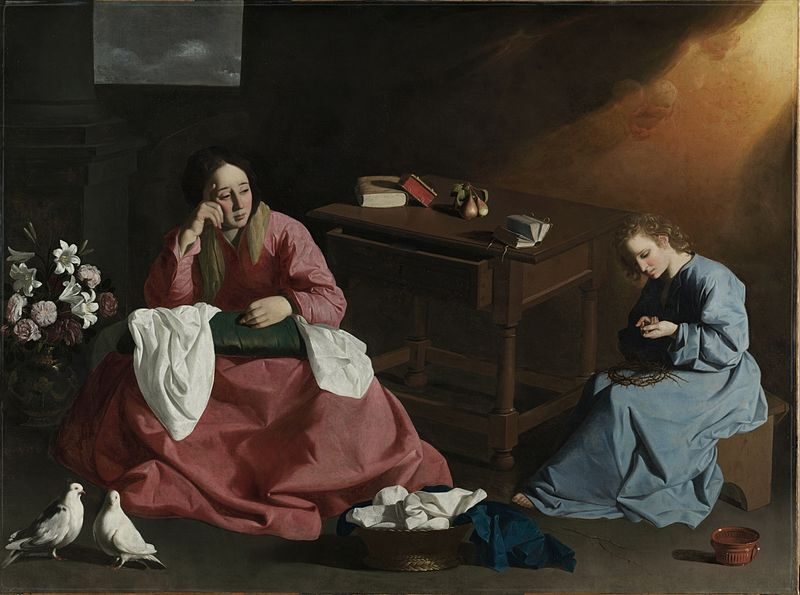
Christ and the Virgin in the House at Nazareth (c. 1631–1640)
Seville’s religious institutions provided numerous commissions for altarpieces and devotional paintings.
In Seville, Zurbarán’s career flourished as he secured important commissions from monasteries and churches. His ability to create powerful religious imagery with stark contrasts and realistic detail earned him recognition among the clergy and nobility.
His establishment in this artistic hub allowed him to absorb influences from contemporaries while developing his unique style.
This period marked the beginning of his rise to prominence as one of Spain’s most important Baroque painters, second only to Velázquez.
Artistic Style and Major Works
Francisco de Zurbarán developed a distinctive artistic approach that combined intense realism with dramatic lighting. His work stands out for its religious intensity, technical precision, and powerful simplicity.
Influence of Caravaggio and Baroque Style
Zurbarán’s style was heavily influenced by Caravaggio’s tenebrism, a technique where most forms appear in shadow while select elements are dramatically illuminated. This created striking contrasts that gave his paintings emotional depth and visual impact.
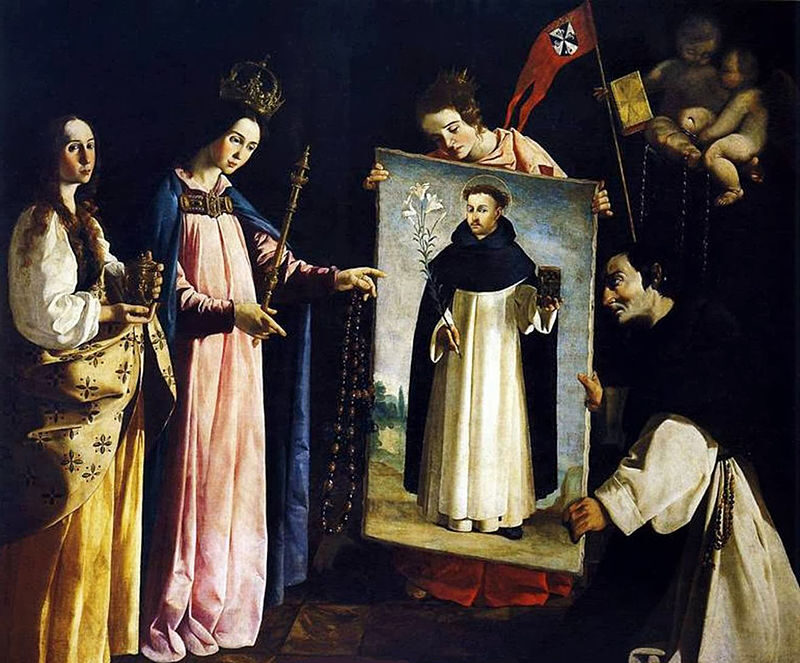
Santo Domingo en Soriano (1626) by Francisco de Zurbarán
He adapted this style to suit Spanish religious sensibilities.
Unlike many Baroque painters who favored complex compositions, Zurbarán preferred simpler arrangements with fewer figures. This approach created a sense of calm contemplation in his works.
His paintings display exceptional attention to texture and fabric, particularly in the rendering of monastic robes. Critics often called him the “Spanish Caravaggio” due to his mastery of light and shadow techniques.
Religious Paintings and Depictions of Saints
Religious subjects dominate Zurbarán’s portfolio, reflecting Spain’s deep Catholic heritage during the Counter-Reformation.
His depictions of monks, nuns, and saints are characterized by quiet dignity and intense spiritual focus.
His monk paintings show solitary figures in deep prayer, their white habits contrasting with dark backgrounds. These works convey both the austerity and spiritual devotion of monastic life.
“Saint Serapion” (1628) stands as one of his most powerful works, showing the martyred saint with haunting realism. His series on Saint Francis displays similar emotional restraint while conveying deep religious feeling.
Zurbarán’s “Immaculate Conception” and “The Annunciation” demonstrate his ability to portray divine subjects with both reverence and humanity.
Iconic Works and Mastery of Realism
“Agnus Dei” (Lamb of God) exemplifies Zurbarán’s remarkable realism. This still life depicts a bound lamb with extraordinary attention to texture and anatomical accuracy. The painting functions both as a still life and as religious symbolism.
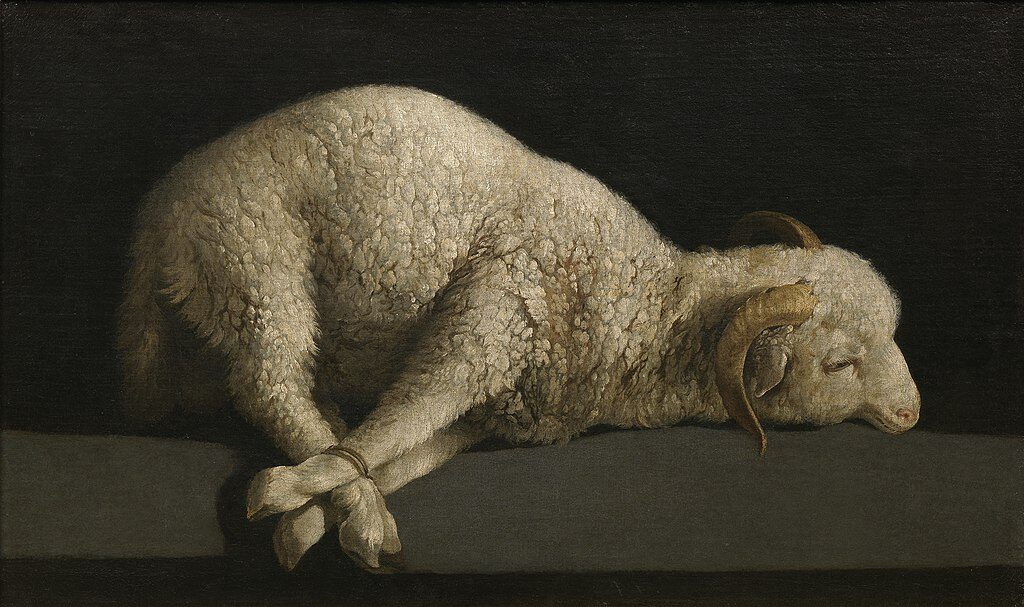
Agnus Dei (c. 1635–1640) by Francisco de Zurbarán
His “Crucifixion” (1627) shows Christ against a stark black background, emphasizing the solemnity of the scene. The dramatic lighting highlights Christ’s body with powerful emotional effect.
Zurbarán’s still lifes feature precisely arranged objects rendered with photographic accuracy. These works demonstrate his technical mastery and eye for composition.
His use of strong, direct lighting helped create a sense of three-dimensionality that made his subjects appear almost tangible. This technique, combined with his restrained palette, gave his works their characteristic solemn power.
Legacy and Influence
Francisco de Zurbarán left an indelible mark on Spanish art history through his distinctive religious paintings and powerful portraiture style. His work continues to influence artists and captivate viewers in major museums around the world.
Reverence in Spanish and Global Art History
Zurbarán stands as one of the greatest masters of Spain’s Golden Age. His unique approach to religious subjects, characterized by Caravaggesque realism and dramatic lighting, earned him recognition alongside contemporaries in the Spanish Baroque movement.

The Defence of Cádiz against the English (1634)
The artist’s influence extended beyond his lifetime, inspiring generations of artists who admired his technical skill and emotional depth.
In Madrid, Zurbarán’s works for the Royal Court established him as a painter of national importance. His distinctive style of depicting monks and nuns from the Dominican Order created a visual language for Spanish spirituality that remains powerful today.
Art historians particularly value his contribution to Spanish devotional painting, where he combined Italian portraiture techniques with Spanish religious fervor.
Works in Major Museums and Collections
Zurbarán’s paintings now grace the walls of prestigious institutions worldwide. El Prado in Madrid houses a significant collection, including some of his most celebrated religious works and still lifes.
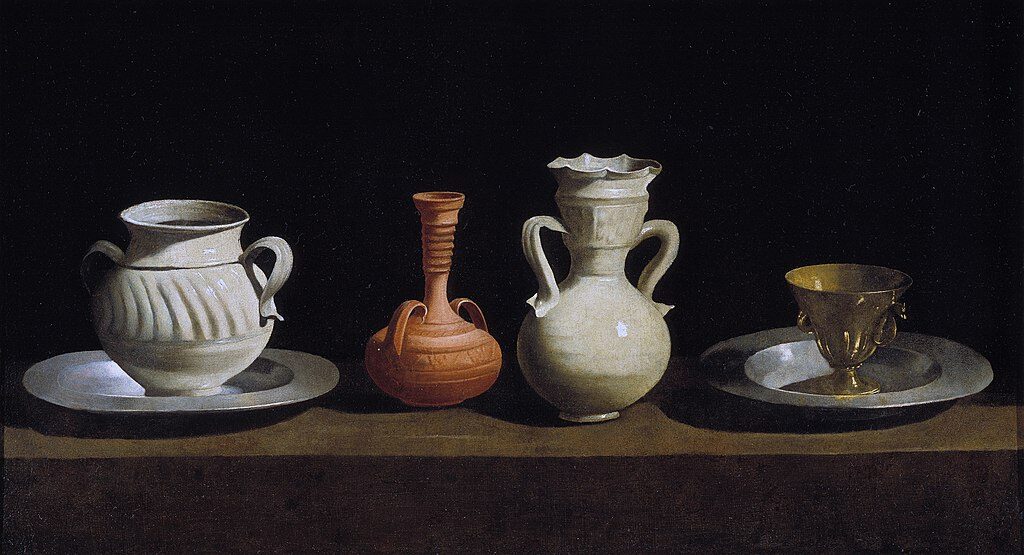
Still Life with Pots (c. 1650) by Francisco de Zurbarán
The Metropolitan Museum of Art showcases important examples of his monastic portraits, demonstrating his ability to capture both physical and spiritual presence. His painting “The Young Virgin” shows his mastery of depicting religious figures with both humanity and divine grace.
The National Gallery of Art and London’s National Gallery include notable works that highlight his technical brilliance and emotional restraint. His paintings from San Pablo el Real monastery exemplify his skill in creating deeply spiritual atmospheres through careful composition and lighting.
These collections ensure Zurbarán’s legacy remains accessible to new generations of art lovers and scholars worldwide.
Frequently Asked Questions
Francisco de Zurbarán’s distinctive artistic legacy combines powerful religious imagery with masterful technique. His contributions to Spanish Baroque painting reflect both his personal devotion and the artistic demands of his era.
What are the defining characteristics of Francisco de Zurbarán’s art style?
Zurbarán’s art style is characterized by strong contrasts of light and shadow, similar to Caravaggio’s tenebrism. This dramatic lighting creates a powerful sense of volume and dimension in his subjects.
His figures appear solid and sculptural, often depicted against plain backgrounds that enhance their monumentality. This approach gives his paintings a stark, meditative quality.
Zurbarán paid meticulous attention to textures, especially in rendering fabrics. His precise brushwork captured the heavy folds of monks’ robes and the delicate details of lace with remarkable accuracy.
How did religious and historical contexts influence Zurbarán’s body of work?
Zurbarán worked during the Counter-Reformation, when the Catholic Church commissioned art to inspire devotion. This religious climate shaped his focus on monasticism, martyrdom, and sacred themes.
Many of his paintings were created for religious orders in Spain, particularly monasteries. These institutions wanted art that would encourage prayer and contemplation among their members.
The Spanish Inquisition’s strict religious oversight influenced Zurbarán’s adherence to orthodox Catholic imagery and symbolism. His work reflects the intense religious devotion of 17th-century Spain.
Which masterpieces is Francisco de Zurbarán best known for creating?
“The House of Nazareth” showcases Zurbarán’s ability to blend domestic simplicity with divine significance. This painting depicts the Holy Family in a humble setting with remarkable attention to ordinary details.
His series of paintings for the Monastery of St. Jerome features powerful depictions of monks in prayer. These works capture the spiritual intensity and ascetic lifestyle of monastic devotion.
“Still Life with Lemons, Oranges and a Rose” is considered one of the finest still-life paintings of the era. It combines simple objects with profound symbolic meaning and demonstrates his mastery of light and texture.
How did Francisco de Zurbarán contribute to the Spanish Golden Age of painting?
Zurbarán helped develop a distinctly Spanish Baroque style that combined Italian influences with local traditions. His work embodied Spain’s devout religious character during its artistic Golden Age.
As the “Spanish Caravaggio,” Zurbarán brought dramatic lighting techniques to religious subjects, creating emotionally powerful images that resonated with Spanish audiences and patrons.
His realistic approach to depicting religious figures made spiritual subjects more accessible to viewers. By portraying saints and biblical characters with human qualities, he bridged the gap between the divine and everyday life.
What was the impact of Francisco de Zurbarán’s paintings on later artists and art movements?
Zurbarán’s stark compositions and dramatic lighting influenced later Spanish painters, particularly in religious art. His approach to simplicity and emotional directness set standards for devotional painting.
In the 19th century, artists like Édouard Manet admired Zurbarán’s still-life paintings. His direct approach to objects and masterful rendering of textures influenced aspects of modern still-life painting.
Contemporary critics recognize Zurbarán’s proto-modern qualities, including his use of geometric composition and psychological intensity. These elements connect his work to much later developments in art history.
In what ways did Francisco de Zurbarán’s technique differ from his contemporaries?
Unlike Velázquez’s loose brushwork, Zurbarán employed a more controlled, precise technique. His paintings show careful attention to detail. This is particularly noticeable in fabrics and textures.
Zurbarán often used starker compositions than his contemporaries. Where others might include elaborate backgrounds, he frequently placed figures against simple, dark settings to heighten dramatic effect.
His color palette was more restrained than many Baroque painters. Rather than rich, varied colors, Zurbarán often worked with limited tones. These create powerful effects through subtle variations of whites, browns, and blacks.

